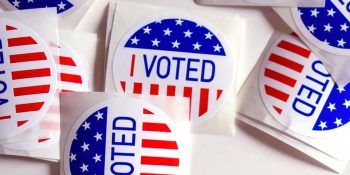Just in time for Election Day, a new study by a team of mathematicians has examined how large social networks, such as blocs of U.S. voters, navigate making tough decisions—especially when time is of the essence.
The team, which includes Zachary Kilpatrick from the University of Colorado Boulder, has discovered that a mix of decision-making strategies might be the secret to success: Groups that are made up of both hasty and more deliberative choosers, he said, seem to have the best odds of coming to the right conclusions.
“We wanted to look at how you can tune a group to have a good amount of these hasty decision-makers so that they’re providing a bump of information to the group, but not so much that they’re ruling the decisions of everyone else,” said Kilpatrick, an associate professor in the Department of Applied Mathematics at CU Boulder.
Kilpatrick noted that the research, which will be published soon in the journal Physical Review Letters, doesn’t delve into the behavior of actual voters. Instead, it tackles a mathematical concept called “rational agents”—hypothetical figures that always make the right selection based on the evidence they have on hand.
But, he said, scientists can still learn a lot by examining how these more idealized predictions line up—or don’t—with the decisions of flesh-and-blood humans.
Using numerical simulations, the team set up scenarios under which groups of rational agents, which ranged in size from 100 agents to nearly 100,000, had to pick between two options. As the simulations progressed, the agents received data that pushed them toward one choice or another.
“We have a continuous update, almost like a stock ticker, of their bias in favor of one choice or another,” Kilpatrick said. “They only make a decision when that stock ticker hits an upper bound or a lower bound.”
There was just one twist: Like voters, Kilpatrick’s agents did not all have the same threshold for making a choice. Some of them didn’t require a lot of information before landing on the option they preferred. Others needed to take their time and weigh a lot more evidence before deciding.
The balance between those two kinds of decision-making strategies seemed to make a big difference, Kilpatrick said.
Pretend your own social network contains a lot of hasty deciders. These seat-of-their-pants people are decisive, but that decisiveness can lead them, and the people who listen to them, into jumping into wrong choices. With too few hasty decision makers, however, the members of a group can get mired in indecision—failing to make any kind of choice at all.
“The hasty decision-makers are sniffing out the environment, and they pass that information on to the more deliberate decision makers,” Kilpatrick said.
The team calculated that networks that contain roughly 2 to 3% hasty decision makers were the most effective: These groups consistently made the best majority decisions in the least amount of time.
Kilpatrick sees a lesson in his study for U.S. voters agonizing over their own upcoming choices.
“There’s a lot of novices out there posting things on social media and they have not used a lot of evidence to come to their conclusions,” Kilpatrick said. “People who listen to them value them as experts, and it can really cloud the decision making of a group.”
SPREAD THE NEWS
COMMENT, Like, Follow & SHARE @I70Scout
CURRENT EDITION
WEATHER & TRAFFIC PUZZLES RECENT NEWS ADVERTISE WITH US

Leave a Reply